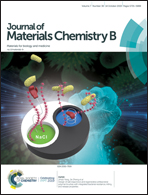Shape memory histocompatible and biodegradable sponges for subcutaneous defect filling and repair: greatly reducing surgical incision†
Abstract
Reducing surgical incision for large area subcutaneous defect filling and repair is a great challenge in the biomedical field, especially for plastic surgery. In this study, a novel hydroxyethyl cellulose/soy protein isolate (HEC/SPI) composite sponge (EHSS) with a fluid responsive shape memory property was constructed, whose thickness could be controlled by hot-pressing conditions to reduce the required surgical incision greatly. Effects of the main factors such as pressure, temperature and hot-pressing cycles on the recovery degree of EHSS were investigated systematically. The structure and physical properties of the sponges were characterized by FTIR spectroscopy, XRD, SEM etc. The results showed that EHSS could be pressed into thin disks with much smaller thickness, and the thickness retention ratio and recovery ratio were affected by hot-pressing conditions such as pressure and temperature. Especially, EHSS could be hot-pressed into a dense thin disk (EHSS-PT-130) at 130 °C with the pressure of 30 MPa, which could quickly recover its original shape by soaking in hydrophilic fluids. EHSS-PT-130 also exhibited good hydrophilicity, cytocompatibility, histocompatibility and in vivo biodegradability. Compared with the original EHSS, in vivo shape memory EHSS-PT-130 required much smaller surgical incision to reach the same repair effect and no need of extra sterilization, showing potential application for subcutaneous defect filling and repair.



 Please wait while we load your content...
Please wait while we load your content...